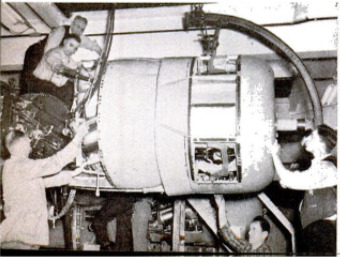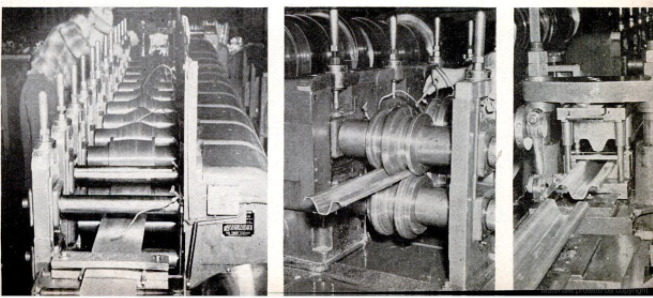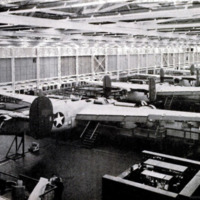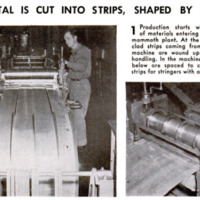-
Title (Dublin Core)
-
The making of U. S. bombers
-
Article Title and/or Image Caption (Dublin Core)
-
Title: Look out Hitler, here come the flood!
-
Subtitle: Liberator bombers rolling off assembly lines show how mass production will swamp the Axis
-
extracted text (Extract Text)
-
I HAVE just spent two days trying to ab-
sorb a quick glimpse of a fantastic fu-
ture. My feet hurt from walking so far;
my eyes ache from straining to see so many
complex things; I feel somewhere between
a state of brain fag and bewilderment, from
trying simply to appreciate the immensity
of an act of industrial imagination and faith
so vast that it is beyond the possibility of
quick human comprehension. I have been
visiting the Willow Run bomber plant,
created in the open country of Michigan
by the Ford Motor Company and the Army
Air Forces.
Willow Run is America’s big all-out at-
tempt to apply the technique of automobile
mass production to the rapid manufacture
of a four-engine bomber—the Liberator, the
Consolidated B-24. Less than two years
ago this vast site was a woodlot among the
fields; most of its thousands of workers
were untrained grocery clerks, farm hands,
stenographers, and home girls. Today,
after passing through all the preliminary
acres of fabrication, you come to four long
assembly-line conveyors, which eventually
merge into two closely packed moving rows
of bombing planes on the verge of comple-
tion. These are not just airplanes, mind
you. The long-distance bomber is the most
complex precision machine ever devised by
man.
How often these assembly lines move—
how frequently planes roll out to join their
predecessors on the plant's great flying field
—no one is permitted to say. In any case,
a figure that is true today would be false a
month from now. But it is possible to say
that Willow Run is running. The river is
rising. Mr. Hitler, here comes the flood!
Those thousand-plane bombing raids over
Germany were mere dress rehearsals, All
the books and articles and talk about air
power and bombing the Axis to its knees—
they were mere advance scriptwriting for
this mechanical drama which now begins to
move. Mystery and secrecy and rumors
have surrounded it. There were whispers
from those who said it couldn't be done, and
from those who said it should have been
done faster. True, there have been monu-
mental difficulties and delays. After all,
Rome was not built in a day. But now that
the curtain lifts a little, it is possible to as-
sure Mussolini that Rome could be de-
stroyed in a few hours.
While Hitler's divisions drove through
France, less than three years ago, Presi-
dent Roosevelt called for an increase of air-
plane production capacity to 50,000 planes
a year. Practically everyone thought he
was talking big, taking a random shot at
the moon. Airplane building was then lit-
tle beyond the handicraft stage, for the sim-
ple reason that big orders for big planes
had been practically nonexistent. But then
the aircraft industry proceeded to work
miracles; and today the President's auda-
cious production aim is a reality, almost a
commonplace. The aircraft industry ac-
complished this by speeding up the natural
development of its already tested methods
of production.
To this miracle Willow Run contributed
very little. This plant is something extra,
added on top of all the rest. It is an at-
tempt, starting from scratch, to encompass
the natural industrial evolution of 20 years
all in one big gulp. In place of the air-
plane craftsman’s method of cut, bend, and
fit—by which fighting planes are still pro-
duced—it seeks to sweep in the principle
of interchangeable parts.
‘Willow Run has been making “parts” for
a long time. This does not sound very im-
pressive, until you discover that in Willow
Run language a “part” may be something
no more simple than a center wing section,
60 feet across—the structural element on
which are assembled the four engines, the
fuselage, the landing gear, and a complex
infinity of hydraulic and electrical controls.
Counting 700,000 rivets, there are 1,250,
000 separate parts in a B-24. You enter the
plant at the manufacturing end, where the
raw sheet duralumin comes in and is cut,
stamped, and molded into these integral
units. As you move on, into the great
acreage devoted to subassemblies, the parts
become more complex. For each part there
is a jig or fixture (the terms seem to be
used * somewhat _ interchangeably, though
most of the Willow Run installations are
properly fixtures) into which the original
parts are fitted and assembled into a precise
pattern. No matter how big or complex, a
“part” thus made will mate precisely with
its adjoining parts, on the assembly line.
Far down the plant, the final assembly
begins to take shape. The 60-foot center
wing section, in crude form, is placed in a
conveyor system, suspended by its ends.
There is not just one of these conveyors;
there are four of them side by side, each
carrying a row of center wing sections on
from station to station, gaining additional
complexity at each stop. At one such sta-
tion, for instance, the wing section en-
counters an Ingersoll milling machine which
simultaneously carries out on it 26 different
machining operations—doing in less than an
hour a complex lot of metalworking which
formerly took days. That is what happens
at just one station.
At last, after the wing section has ac.
quired its landing wheels, the four conveyor
lines are drawn together into two final as-
sembly lines pulled by underground cables.
This makes room for the planes to take on
their outer wing sections and attain their
full spread of 110 feet.
Elements of mass production have been
introduced in all military-airplane plants.
At Willow Run, planned originally for mass
production, the Ford organization has in-
troduced speed-up changes which fall into
four main categories. They can best be
made clear by taking them up one at a
time.
1. The use of great, heavy presses with
hard steel dies, such as are used for stamp-
ing out automobile bodies, for drawing,
bending, cutting, and forming various du-
ralumin parts.
The big Ford presses stamp out parts like
50 many biscuits, but it required great in-
genuity to make this possible. Special
steels had been developed for automobile
stamping, and the special properties of air-
plane metal were quite different. Its cold
flow is such that it tends to wrinkle and
fold; dies had to be devised to allow for
this. There were those who thought it im-
possible, but it has been done.
Outstanding in the press work are the
complicated frameworks for such parts as
the pilot's and bombardier’s transparent en-
closures. A single stamping in one case
now forms a piece formerly made with 33
parts. This was accomplished by using a
softer, thicker grade of metal, which would
draw better. The extra weight was counter-
balanced by elimination of rivets and over-
lapping joints.
2. Better tooling than the airplane indus-
try ever before could afford. In small avia-
tion contracting the tooling cost was always
the most dangerous item. At Willow Run
no expense was spared to get the best tool
for each operation; and the jigs and fixtures
are more accessible and more heavily con-
structed than ever before. For assembling
stringers, for instance, it had been custom-
ary to use loftboards—great tables bearing
full-scale drawings, which made workmen
dependent on ink or pencil marks for their
dimensions. At Willow Run every such op-
eration has its own steel bench or frame-
work, with dimensions unalterably and pre-
cisely fixed in tool steel.
3. The plane is broken down into smaller
parts for subassembly than ever before.
The jigs and fixtures are so constructed
that “detailed installations can be made
long before the final assembly line has
been reached.
When an airplane fuselage is built as a
unit, for instance, its interior is a very
crowded place in Which to work. In the
forward section of a fuselage, a half dozen
workers would find themselves crowded and
interfering with each other. But when that
section is constructed as four separate pan-
els—top, bottom, right, and left, then two
dozen men can work on the interiors of these
panels simultaneously with plenty of room.
4. The final big
factor is that Willow Run, no matter how
Dig, is still only one part of the Ford empire.
When forgings and castings are needed in
a hurry, they can be whipped out quickly,
at the River Rouge plant without any wait-
ing. When special problems arise, specialists,
laboratories, and instruments are available.
Those are the advantages of Willow Run
as it moves in to stack its productive ca-
pacity alongside that of the established air-
craft industry. Its great disadvantage has
been inexperienced manpower. Generally
speaking, it has been necessary to train the
thousands of workers right from the funda-
mentals up. The plant's apprentice school
was started long before the factory was
complete, and employee attendance at school
today exceeds 8,000 student hours a week.
‘The crucial shortage is in experienced pro-
duction men, men Who know how to organ-
ize the sequence of operations and get them
moving. While Willow Run was getting
ready to start, many such men were
snapped up by other plants and other indus-
tries. However, despite rumors and criti-
cisms to the contrary, it can be stated at
this writing that Willow Run is running on
schedule; in quantity and in quality its out-
put is up to the standard set for it in ad-
vance. By its very nature, mass production
takes a long time to get started; but when
it moves, it moves fast!
Up to now, Willow Run's capacity for
making parts far exceeds its final assembly
output. For one thing, the place was origi-
nally projected as a parts plant, for making
subassemblies to be shipped to final plants
in Texas and Oklahoma. Planes are mov-
ing in this way now in great trailers de-
signed for the purpose—vans big enough to
enclose a 60-foot center wing section. Two
of these road freighters, 73 feet over all for
tractor and trailer, carry all but the engines
of one B-24. They are moving monuments
to the way some production planners were
thinking in the days before the rubber and
gasoline shortages.
That way of thinking seems to be on the
way out. The final assembly line is taking
more and more “parts.” The river is high
on the banks of the tributaries upstream.
Farther down it's about time for the flood.
-
Contributor (Dublin Core)
-
Hickman Powell (Article Writer)
-
Ford Motor Company (Photos)
-
Language (Dublin Core)
-
eng
-
Date Issued (Dublin Core)
-
1943-05
-
pages (Bibliographic Ontology)
-
78-85,202
-
Rights (Dublin Core)
-
Public Domain (Google Digitized)
-
Archived by (Dublin Core)
-
Matteo Ridolfi
-
Marco Bortolami (editor)
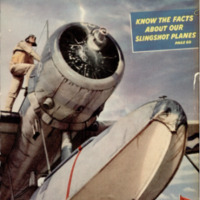 Popular Science Monthly, v. 142, n. 5, 1943
Popular Science Monthly, v. 142, n. 5, 1943


